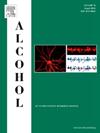Voluntary wheel-running reduces harmful drinking in a genetic risk model for drinking to intoxication
IF 2.9
4区 医学
Q3 PHARMACOLOGY & PHARMACY
引用次数: 0
Abstract
Physical activity (PA) may provide an effective and equitable treatment option for addressing the harm associated with Alcohol Use Disorders (AUDs). Wheel-running (WR) – a well characterized rodent model of PA – reduces intake and craving for many drugs of abuse; however, its effects on models of harmful ethanol intake are mixed. This may in part be due to critical differences in drinking paradigm, genetics background, chronicity of ethanol, and the modality and duration of PA being tested. To compliment and extend prior work, we evaluated whether key stages of PA development would differentially reduce binge-like ethanol drinking in inbred High Drinking in the Dark (iHDID-1) mice, a unique genetic risk model for drinking to intoxication. AUD is a chronic, relapsing disorder. To better reflect this condition, adult female and male iHDID-1 mice underwent a chronic (4-weeks) “Drinking in the Dark” (DID) protocol – a model of binge-like ethanol drinking - along with a locked running (to control for the effect of novelty). Early stages of PA evoke much higher signs of physiological and neurological stress than more chronic, habitual stages of PA. Therefore, we tested whether acute WR (1-week) altered ethanol intake differently than chronic WR (4-weeks). Here, we found that both acute and chronic WR reduced ethanol intake in female and male iHDID-1 mice. To evaluate whether the effect of PA was specific to ethanol, we further tested whether acute WR reduced water intake in the DID protocol. Analysis revealed that male WR iHDID-1 mice had greater water intake than wheel-locked controls. Moreover, WR during the time of DID was positively correlated with water intake, but not ethanol intake, suggesting WR and DID are not competing behaviors. Taken together, these findings offer support for the role of PA as a meaningful intervention strategy for reducing harmful drinking and emphasize the need to explore the underlying neurobiological mechanisms as a means of guiding PA as an adjunctive therapy for AUD.
自愿跑轮减少有害饮酒在饮酒中毒的遗传风险模型。
体育活动(PA)可能为解决与酒精使用障碍(AUDs)相关的危害提供一种有效和公平的治疗选择。轮跑(WR) -一种典型的PA啮齿动物模型-减少了对许多滥用药物的摄入和渴望;然而,它对有害乙醇摄入模型的影响是混合的。这可能部分是由于饮酒模式、遗传背景、乙醇的慢性性以及PA测试的方式和持续时间的关键差异。为了补充和扩展先前的工作,我们评估了PA发育的关键阶段是否会在近交系的夜间高饮酒量小鼠(iHDID-1)中不同程度地减少酗酒样乙醇饮酒,这是一种独特的饮酒中毒遗传风险模型。AUD是一种慢性、复发性疾病。为了更好地反映这种情况,成年雌性和雄性iHDID-1小鼠进行了慢性(4周)“在黑暗中饮酒”(DID)协议——一种类似酒精狂饮的模式——以及锁定跑步(以控制新奇的效果)。早期的PA比慢性的、习惯性的PA更容易引起生理和神经方面的压力。因此,我们测试了急性WR(1周)对乙醇摄入的改变是否与慢性WR(4周)不同。在这里,我们发现急性和慢性WR都减少了雌性和雄性iHDID-1小鼠的乙醇摄入量。为了评估PA的作用是否对乙醇有特异性,我们进一步测试了急性WR是否减少了DID方案中的水摄入量。分析显示,雄性WR iHDID-1小鼠的饮水量比车轮锁定对照组大。此外,在DID期间的WR与水摄入量呈正相关,而与乙醇摄入量无关,表明WR和DID不是竞争行为。综上所述,这些发现为PA作为减少有害饮酒的有意义的干预策略的作用提供了支持,并强调了探索潜在的神经生物学机制作为指导PA作为AUD辅助治疗手段的必要性。
本文章由计算机程序翻译,如有差异,请以英文原文为准。
求助全文
约1分钟内获得全文
求助全文
来源期刊

Alcohol
医学-毒理学
CiteScore
4.60
自引率
4.30%
发文量
74
审稿时长
15.6 weeks
期刊介绍:
Alcohol is an international, peer-reviewed journal that is devoted to publishing multi-disciplinary biomedical research on all aspects of the actions or effects of alcohol on the nervous system or on other organ systems. Emphasis is given to studies into the causes and consequences of alcohol abuse and alcoholism, and biomedical aspects of diagnosis, etiology, treatment or prevention of alcohol-related health effects.
Intended for both research scientists and practicing clinicians, the journal publishes original research on the neurobiological, neurobehavioral, and pathophysiological processes associated with alcohol drinking, alcohol abuse, alcohol-seeking behavior, tolerance, dependence, withdrawal, protracted abstinence, and relapse. In addition, the journal reports studies on the effects alcohol on brain mechanisms of neuroplasticity over the life span, biological factors associated with adolescent alcohol abuse, pharmacotherapeutic strategies in the treatment of alcoholism, biological and biochemical markers of alcohol abuse and alcoholism, pathological effects of uncontrolled drinking, biomedical and molecular factors in the effects on liver, immune system, and other organ systems, and biomedical aspects of fetal alcohol spectrum disorder including mechanisms of damage, diagnosis and early detection, treatment, and prevention. Articles are published from all levels of biomedical inquiry, including the following: molecular and cellular studies of alcohol''s actions in vitro and in vivo; animal model studies of genetic, pharmacological, behavioral, developmental or pathophysiological aspects of alcohol; human studies of genetic, behavioral, cognitive, neuroimaging, or pathological aspects of alcohol drinking; clinical studies of diagnosis (including dual diagnosis), treatment, prevention, and epidemiology. The journal will publish 9 issues per year; the accepted abbreviation for Alcohol for bibliographic citation is Alcohol.
 求助内容:
求助内容: 应助结果提醒方式:
应助结果提醒方式:


